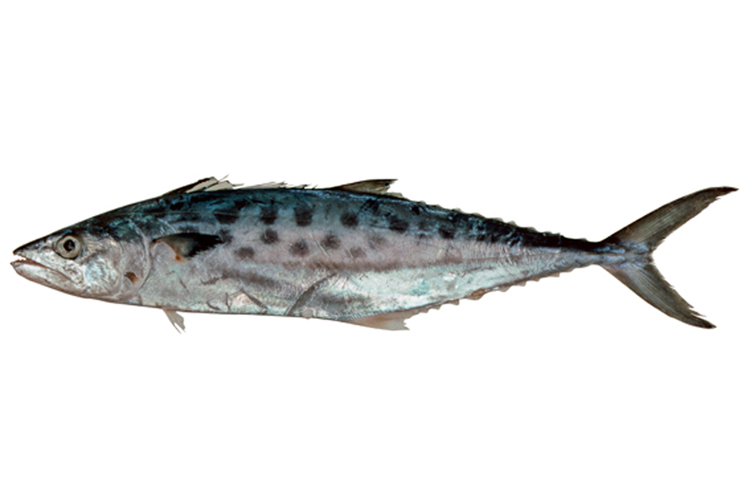- Classification
- ACTINOPTERYGII
- PERCIFORMES
- SCOMBRIDAE
- Scomberomorus
- queenslandicus
School Mackerel, Scomberomorus queenslandicus Munro 1943

School Mackerel, Scomberomorus queenslandicus. Source: Australian National Fish Collection, CSIRO. License: CC BY Attribution-Noncommercial
This popular recreational species is considered to be an excellent table fish.
School Mackerel, Scomberomorus queenslandicus Munro 1943
More Info
|
Distribution |
Known only from tropical and subtropical waters of northern Australia and southern Papua New Guinea; found in Australian waters from Shark Bay (WA) to Sydney (NSW). An epipelagic, neritic schooling species that follows their baitfish prey into bays and estuaries during the austral winter and spring. |
|
Features |
Meristic features: Body elongate and strongly compressed. Both jaws with a single series of 5-38 sharp triangular teeth. Body covered in small scales, no anterior corselet present. Single lateral line gradually curving down toward caudal peduncle. Caudal peduncle with well-developed keel, flanked on each side by a smaller keel. Swimbladder absent. |
|
Size |
To at least 100 cm and 8 kg. |
|
Colour |
Dark bluish-green above, sides silvery with about three indefinite rows of greyish-bronze blotches (absent in juveniles less than 95 mm); membrane of first dorsal fin black, with white patch between sixth and last dorsal spine. Second dorsal fin, dorsal finlets, pectoral fins and caudal fin grey; pelvic fins, anal fin and anal finlets white. |
|
Feeding |
Feeds predominantly on baitfishes such as clupeoids and anchovies. During the larval stage this species feeds on other larval fishes and invertebrates. |
|
Biology |
Females attain maturity between 401 and 450 mm, males between 351 and 400 mm (fork lengths). In Queensland waters, spawning occurs between October and January. |
|
Fisheries |
Although not targetted commercially, this species is taken as bycatch in the Spanish Mackerel fishery. |
|
Conservation |
|
|
Etymology |
The specific name queenslandicus refers to the type locality. |
|
Species Citation |
Scomberomorus (Cybium) queenslandicus Munro 1943, Mem. Queensl. Mus. 12(2): 82, Pls. 7 (fig. B), 8 (fig. 1). Tyep locality: Cape Cleveland, northern Queensland, Australia. |
|
Author |
Dianne J. Bray & S. Schultz |
School Mackerel, Scomberomorus queenslandicus Munro 1943
References
Allan, R. 2002. Australian Fish and How to Catch Them. Sydney : New Holland Publishers (Australia) 394 pp.
Allen, G.R. 1997. Marine Fishes of Tropical Australia and South-east Asia. Perth : Western Australian Museum 292 pp. 106 pls.
Allen, G.R. & Swainston, R. 1988. The Marine Fishes of North-Western Australia. A field guide for anglers and divers. Perth, WA : Western Australian Museum vi 201 pp., 70 pls.
Anonymous. 2006. East coast Spanish Mackerel Fishery. The State of Queensland, Department of Primary Industries and Fisheries. Available online at http://www2.dpi.qld.gov.au/extra/pdf/fishweb/sp_mackerel_reports/SMAnnualStatusreport.pdf Accessed 13-05-2008
Begg, G.A. & G.A. Hopper. 1997. Feeding patterns of school mackerel (Scomberomorus queenslandicus) and spotted mackerel (S. munroi) in Queensland east-coast waters. Marine and Freshwater Research 48: 565-571.
Begg, G.A. 1998. Reproductive biology of school mackerel (Scomberomorus queenslandicus) and spotted mackerel (S. munroi) in Queensland east-coast waters. Marine and Freshwater Research 49: 261-270
Collette, B.B. 2001. Scombridae. pp. 3721-3756 in Carpenter, K.E. & Niem, T.H. (eds). The Living Marine Resources of the Western Central Pacific. FAO Species Identification Guide for Fisheries Purposes. Rome : FAO Vol. 6 pp. 3381-4218.
Collette, B.B. & Nauen, C.E. 1983. FAO species catalogue. Scombrids of the world. An annotated and illustrated catalogue of tunas, mackerels, bonitos and related species known to date. Fisheries Synopsis No. 125, Vol. 2. Rome : FAO. 137 pp. 81 figs
Collette, B.B. & Russo, J.L. 1985. Morphology, systematics, and biology of the Spanish mackerels (Scomberomorus, Scombridae). Fishery Bulletin (U.S.) 82: 545-692, 70 figs
Fraser-Brunner, A. 1950. The fishes of the family Scombridae. Annals and Magazine of Natural History 12 3(7): 131-163 figs 1-35
Gloerfelt-Tarp, T. & Kailola, P.J. 1984. Trawled Fishes of Southern Indonesia and Northwest Australia. Jakarta : Dir. Gen. Fish. (Indonesia), German Tech. Coop., Aust. Dev. Ass. Bur. 406 pp.
Grant, E.M. 1975. Guide to Fishes. Brisbane : Queensland Government, Co-ordinator General’s Department 640 pp.
Hutchins, B. 2004. Fishes of the Dampier Archipelago, Western Australia. Records of the Western Australian Museum, Supplement 66: 343–398
Johnson, J.W. 2010. Fishes of the Moreton Bay Marine Park and adjacent continental shelf waters, Queensland, Australia. pp. 299-353 in Davie, P.J.F. & Phillips, J.A. Proceedings of the Thirteenth International Marine Biological Workshop, The Marine Fauna and Flora of Moreton Bay. Memoirs of the Queensland Museum 54(3)
Kailola, P.J., Williams, M.J., Stewart, P.C., Reichelt, R.E., McNee, A. & Grieve, C. 1993. Australian Fisheries Resources. Canberra : Bureau of Resource Sciences and the Fisheries Research and Development Corporation 422 pp.
Larson, H.K. & Williams, R.S. 1997. Darwin Harbour fishes: a survey and annotated checklist. pp. 339-380 in Hanley, H.R., Caswell, G., Megirian, D. & Larson, H.K. (eds). The Marine Flora and Fauna of Darwin Harbour, Northern Territory, Australia. Proceedings of the Sixth International Marine Biology Workshop. Darwin : Museum and Art Gallery of the Northern Territory 466 pp.
Marshall, T.C. 1964. Fishes of the Great Barrier Reef and Coastal Waters of Queensland. Sydney : Angus & Robertson 566 pp. 136 pls.
Munro, I.S.R. 1943. Revision of Australian species of Scomberomorus. Memoirs of the Queensland Museum 12(2): 65-95 figs 1-4 pls 6-8
Randall, J.E., Allen, G.R. & Steene, R. 1990. Fishes of the Great Barrier Reef and Coral Sea. Bathurst : Crawford House Press 507 pp. figs.
Randall, J.E., Allen, G.R. & Steene, R. 1997. Fishes of the Great Barrier Reef and Coral Sea. Bathurst : Crawford House Press 557 pp. figs.
Russell, B.C. & Houston, W. 1989. Offshore fishes of the Arafura Sea. The Beagle, Records of the Museums and Art Galleries of the Northern Territory 6(1): 69-84
Sainsbury, K.J., Kailola, P.J. & Leyland, G.G. 1985. Continental Shelf Fishes of Northern and North-Western Australia. Canberra : Fisheries Information Service 375 pp. figs & pls.
Yearsley, G.K., Last, P.R. & Ward, R.D. (eds) 1999. Australian Seafood Handbook. Hobart : CSIRO Marine Research 460 pp.

